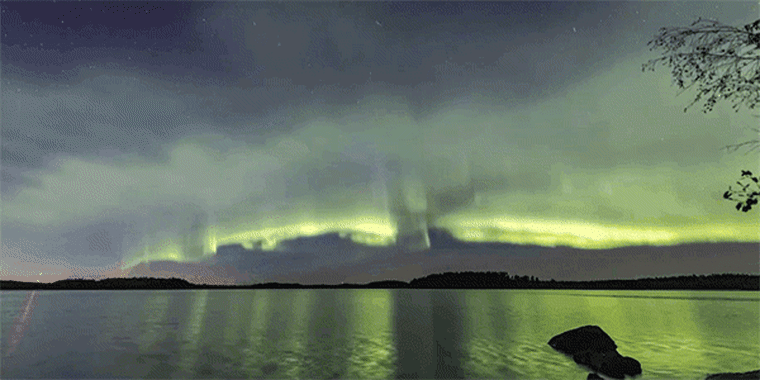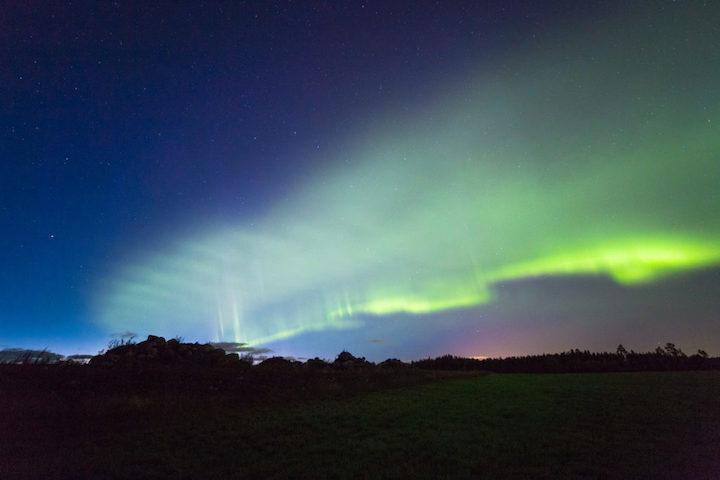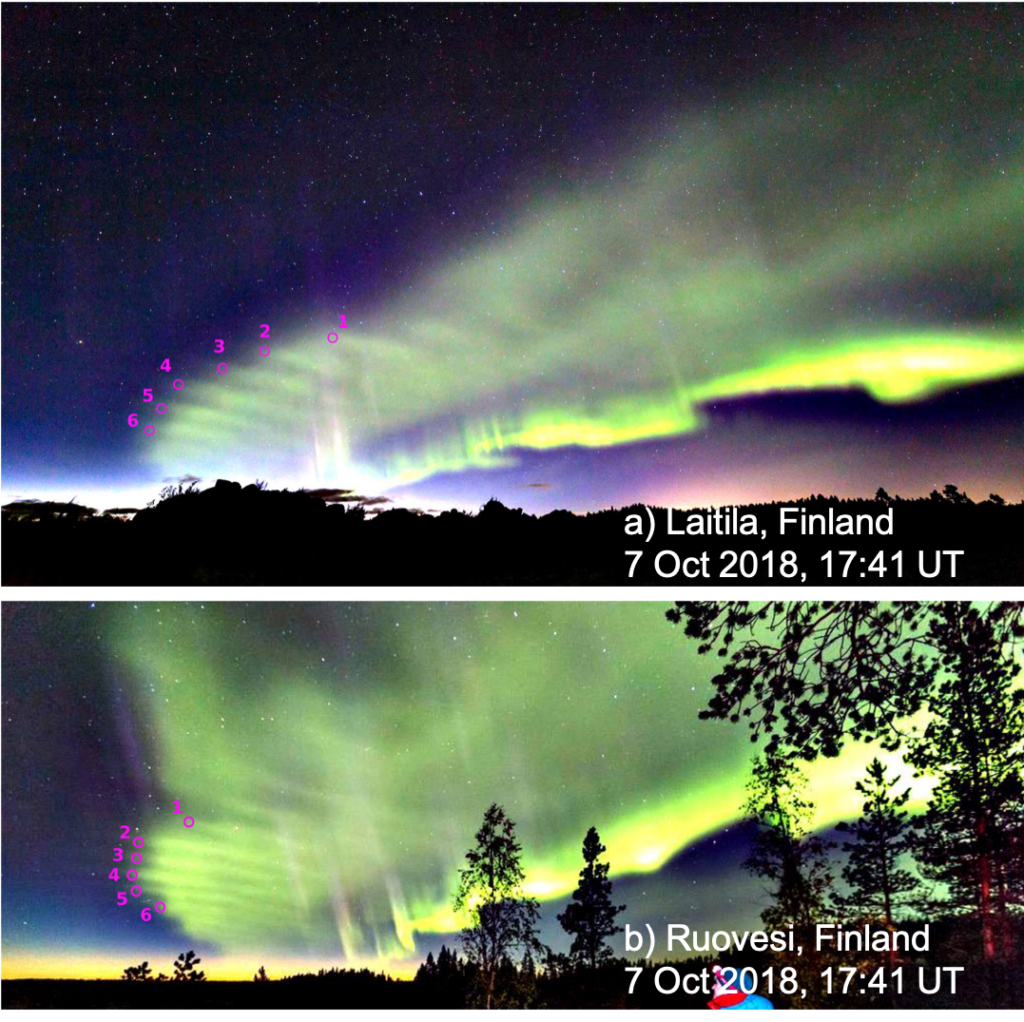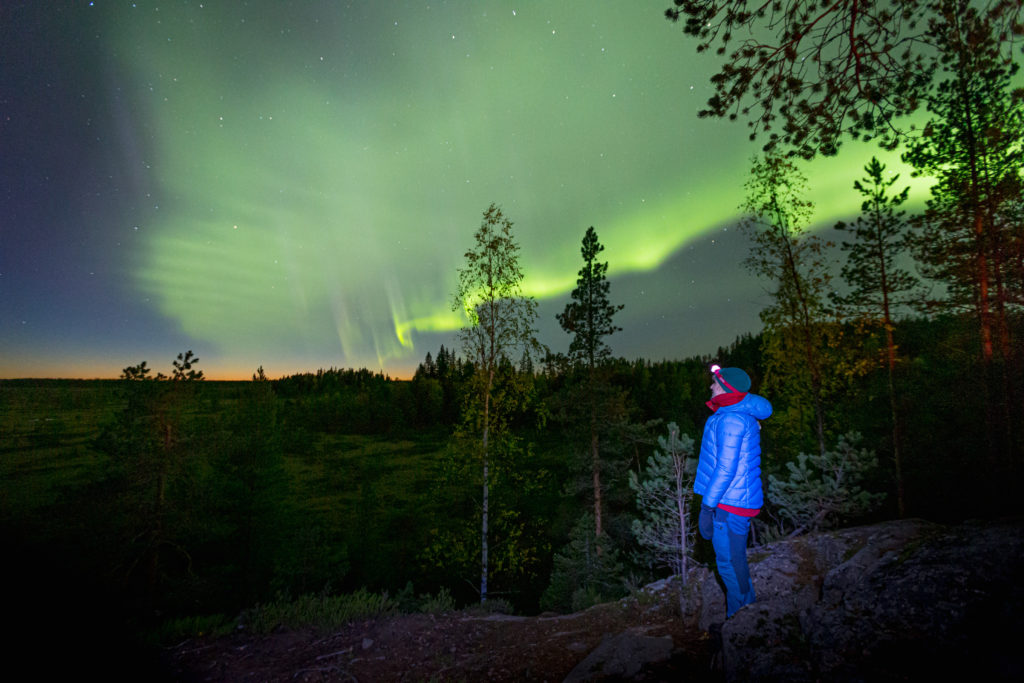31.01.2020
In October 2018, several aurora enthusiasts who regularly photograph the shimmering lights noticed something unusual.

Auroral dunes photographed on Oct 7, 2018 near Laitila, Finland.
Skywatchers in Finland are no stranger to auroras.
These dramatic nighttime light shows typically grace the Finnish skies roughly 200 nights out of the year. But in October 2018, several aurora enthusiasts who regularly photograph the shimmering lights noticed something unusual.
Where the lights of regular auroras are typically arranged vertically to create a rippling, curtain-like effect, the skywatchers instead saw luminous green arcs structured horizontally and extending hundreds of miles toward the horizon.
Now, new research has found that these unusual displays are a new type of aurora, nicknamed “the dunes” because their appearance in the night sky resembles wind-sculpted ridges. Scientists say studying how these auroras form could help them better understand the process by which charged particles from space interact with Earth’s upper atmosphere.

“There are all kinds of things that happen in an aurora that are signs of what is happening in outer space,” said Minna Palmroth, a space physicist at the University of Helsinki and lead author of a study published Tuesday in the journal AGU Advances that details the dunes. “The auroras are like fingerprints.”
Auroras occur when electrons ejected from the sun bombard Earth’s magnetic field and interact with gases in the planet’s atmosphere to create the stunning green, purple, red and blue lights of the northern and southern lights.
Palmroth and her colleagues studied the dunes and noticed that in addition to their horizontal alignment, the lights appeared to undulate like a wave in the night sky.
The researchers think the dunes may get their appearance from so-called atmospheric waves in a layer of the Earth’s upper atmosphere, 50 to 75 miles above the surface. It’s a region of the atmosphere that is not well studied, but Palmroth said the dunes could offer some unique insights.
“When electrons from space collide with atmospheric oxygen in denser parts of the wave, they emit more light,” she said. “In the wave’s trough, you don’t see as much light.”
Quelle: NBCNews
----
Update: 3.02.2020
.
CITIZEN SCIENTISTS DISCOVER NEW TYPE OF AURORA NAMED ‘THE DUNES’ (VIDEO AVAILABLE)

Auroral dunes photographed on Oct 7, 2018 near Laitila, Finland.
Credit: Pirjo Koski.
WASHINGTON—A new type of aurora called “the dunes” discovered by aurora chasers in Finland is helping scientists better understand a mysterious layer of Earth’s atmosphere.
The aurora – nighttime light displays in the atmosphere near Earth’s poles – take on various shapes and forms. They often appear as rippling curtains of green, red, or purple light. But in October 2018, amateur auroral photographers in Finland discovered a new auroral form they dubbed “the dunes.”
The dunes appear as thin ribbons of green light in the sky, extending toward the equator for hundreds of kilometers. Most auroral light displays are oriented vertically, like curtains hanging down from the sky, but the dunes are arranged horizontally, like fingers reaching toward the horizon.
Space physicists at the University of Helsinki worked with citizen scientists who first saw the dunes to determine their altitude and have come up with a theory to explain how they form. They report the discovery and their theory in a new study in AGU Advances. The study is one of the first papers published in this highly selective journal of full length, high-impact research articles across all of Earth and space science.
The researchers suspect the dunes are visible manifestations of undulations of air called atmospheric waves. If their theory proves correct, the dunes could provide a way to understand a part of Earth’s upper atmosphere that is notoriously difficult to study. This region of the atmosphere, roughly 80 to 120 kilometers (50 to 75 miles) about Earth’s surface, is sensitive to changes in energy from the Sun and Earth’s lower atmosphere. Energy fluctuations in this region can indirectly affect the trajectories of Earth-orbiting satellites and spacecraft reentry.
“For the first time we can actually observe atmospheric waves through the aurora – this is something that hasn’t been done before,” said Minna Palmroth, a space physicist at the University of Helsinki and lead author of the new study.
A new kind of light show
A group of auroral enthusiasts approached Palmroth several years ago to have her explain the different types of aurora and the physics behind the stunning light shows. Palmroth wrote and published a guidebook to observing the aurora for the amateur observers, but in October 2018, they approached her with questions about a kind of aurora not mentioned in the book.
“Some of the citizens saw the dunes in the sky, and they told me I had excluded one auroral form from the book,” Palmroth said. It turned out the citizens had observed a completely new type of aurora scientists hadn’t seen before.

Auroral dunes photographed on Oct 7, 2018 near Laitila, Finland (top) and Ruovesi, Finland (bottom). The two photographs were taken simultaneously. The dunes, marked by magenta circles and numbers, extend equatorward from the discrete bright arc in the north.
Credit: AGU Advances/Palmroth et al.
Palmroth organized the group to photograph the dunes in multiple locations throughout Finland on October 7, 2018.
“One of the most memorable moments of our research collaboration was when the phenomenon appeared at that specific time and we were able to examine it in real time,” said auroral hobbyist Matti Helin, a co-author of the new study.
Maxime Grandin, a colleague of Palmroth’s at the University of Helsinki, used the citizen scientists’ photos to calculate the altitude at which the dunes were appearing. Grandin found the dunes appear in a thin layer around 100 kilometers (60 miles) above sea level. Knowing the altitude of the dunes helped the researchers determine the physics behind the unusual streams of light.
“Different auroral forms are like fingerprints,” Palmroth said. “If you see a certain auroral form, you know basically from that form what’s happening further out in space.”
Seeing the unseen
Palmroth and her colleagues suspect the dunes are visible manifestations of a kind of atmospheric wave called mesospheric bores. Atmospheric waves are undulations of air caused by the atmosphere having regions of different temperature or density. Mesospheric bores are waves that propagate through the atmosphere, like ripples spreading in a pool, creating curls and folds that bend horizontally and spread out over long distances.
Now, by studying the dunes, space physicists can better understand these types of waves and the parts of Earth’s upper atmosphere where they occur. These altitudes are too high for balloons and planes to reach but too low for satellites and spacecraft to directly observe them, making them difficult to study.
“The first step that they took here gives us a great deal of information and it shows us the direction we need to move, so to me that’s fantastic,” said Bea Gallardo-Lacourt, a space physicist at the University of Calgary in Canada who was not connected to the new study. Gallardo-Lacourt was part of the team of researchers who determined the celestial phenomenon STEVE was not a kind of aurora but a different phenomenon altogether. Like the dunes, STEVE was discovered by amateur aurora hunters.
Palmroth and her colleagues found the dunes occur simultaneously and in the same region where the electromagnetic energy from space is transferred to Earth’s upper atmosphere. Palmroth suspects this energy transfer may be linked with the creation of the mesospheric bores through a phenomenon called Joule heating, where electrical currents from charged particles flow through the upper atmosphere and create heat.
“We now suggest that this additional energy from Joule heating could give you the circumstances where the bores can originate… and this is a totally new topic,” she said. “We are rather excited.”
Quelle: AGU


